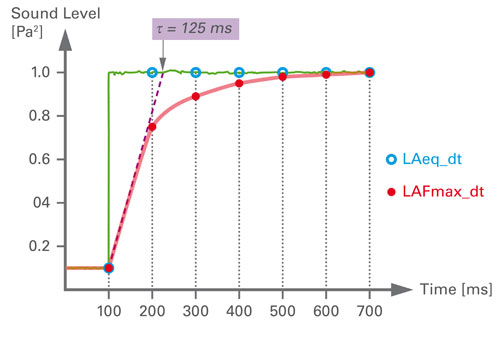The LAeq is one of the most widely used measurements in acoustics, and represents the energy averaged over time (according to IEC 61672 standard). In contrast, the term LAFmax (or LASmax) designates the maximum sound level that occurred during the observation period.
If the measurement duration is sufficiently short, e.g. 100 ms, then the average level can be higher than the maximum sound level within that time period.
The reason is the time weighting. The sound level Lmax, by definition, responds to an increasing level by the rising time constant t, and therefore does not respond immediately to increases. t is defined as 125 ms for the Fast time weighting and 1 sec. for the Slow time weighting. In contrast, no time weighting is applied when measuring the mean value LAeq.
Now, if observation period or, technically expressed, the time interval dt, is shorter than the "reaction time" of the maximum level LFmax, then the mean value LAeq may be actually above the maximum value Lmax.
The following picture illustrates an example:

In the example, we see that the instantaneous sound level, illustrated by the green line, suddenly increases at 100 ms. The Lmax measurements (measured every 100 ms and illustrated by the red dots) have a delayed response to this steeply rising edge due to the time weighting, and therefore reach the new maximum level only at 700 ms. The mean Leq (blue circles), again measured every 100 ms, incorporates the jump without delay, and thus shows a value higher than the Lmax until the 700 ms point.
| Time [ms] |
LAeq_dt [Pa2] |
LAFmax_dt [Pa2] |
| 100 |
0.1 |
0.1 |
| 200 |
1.0 |
0.75 |
| 300 |
1.0 |
0.89 |
| 400 |
1.0 |
0.95 |
| 500 |
1.0 |
0.98 |
| 600 |
1.0 |
0.99 |
| 700 |
1.0 |
1.0 |